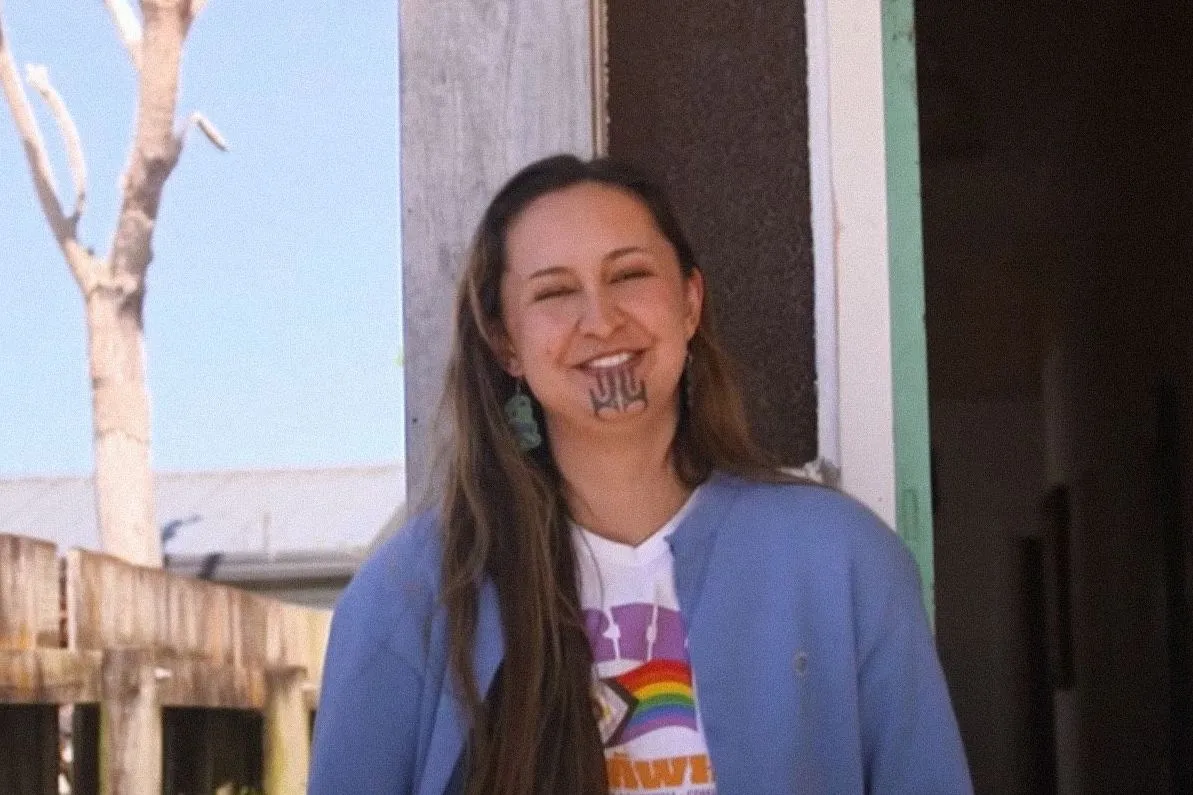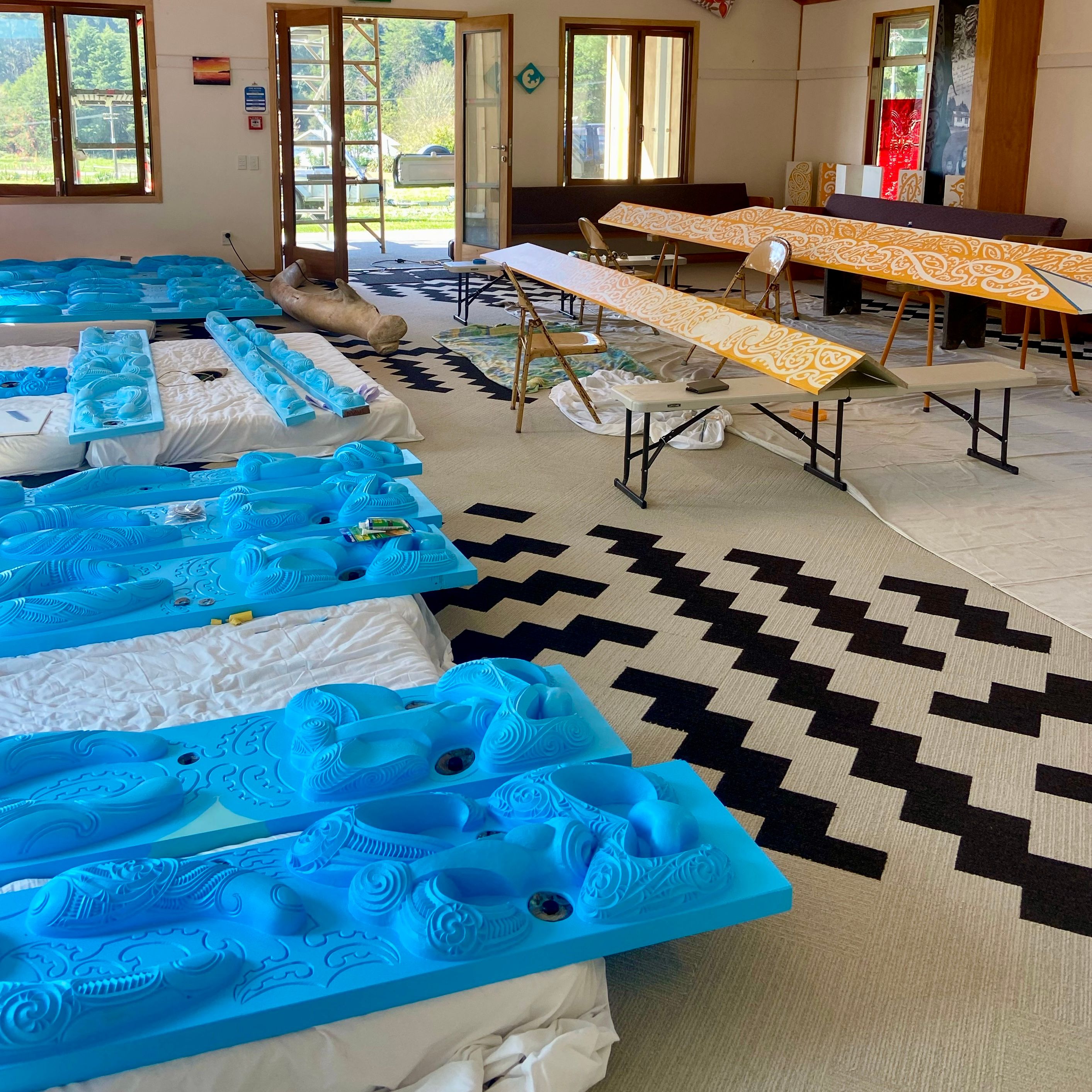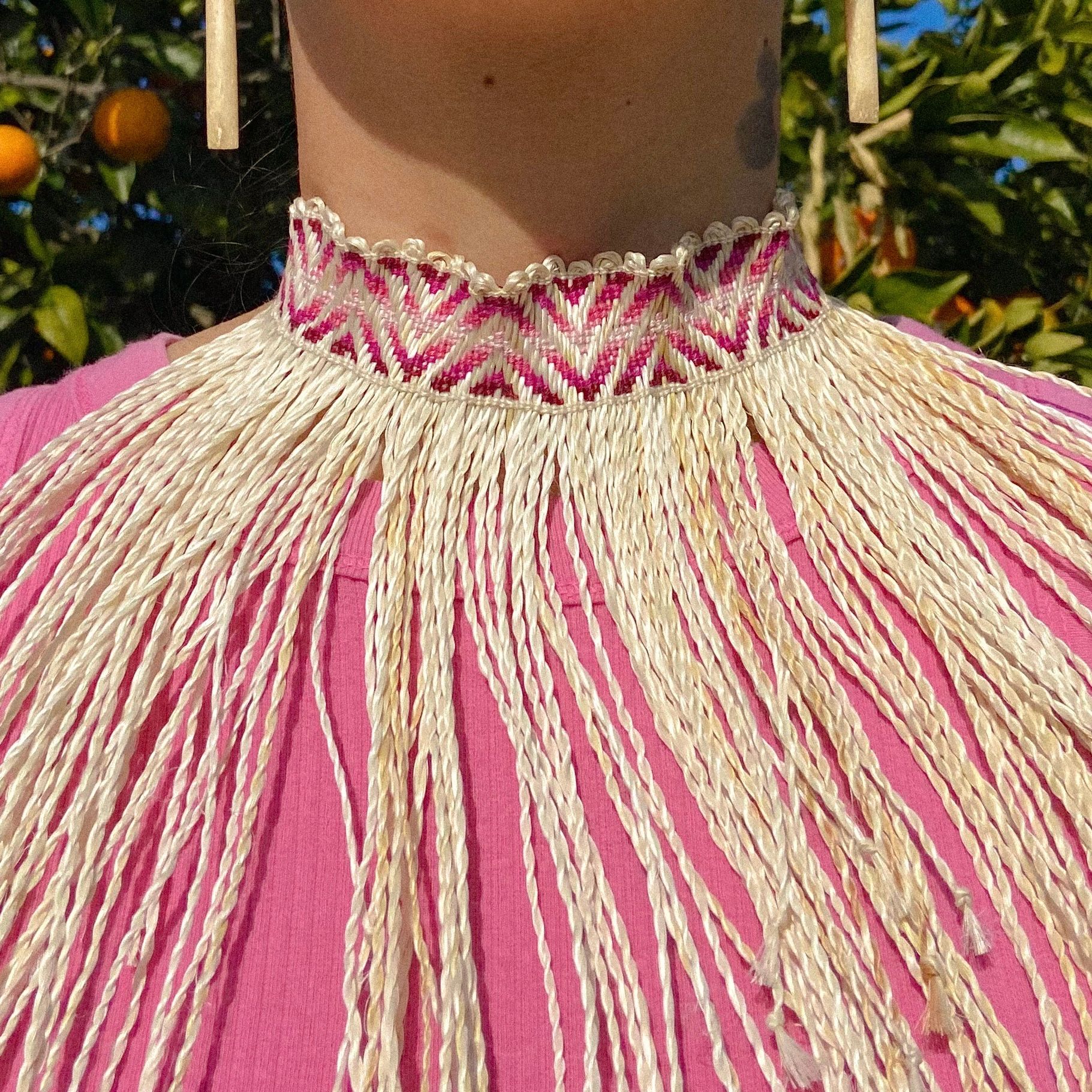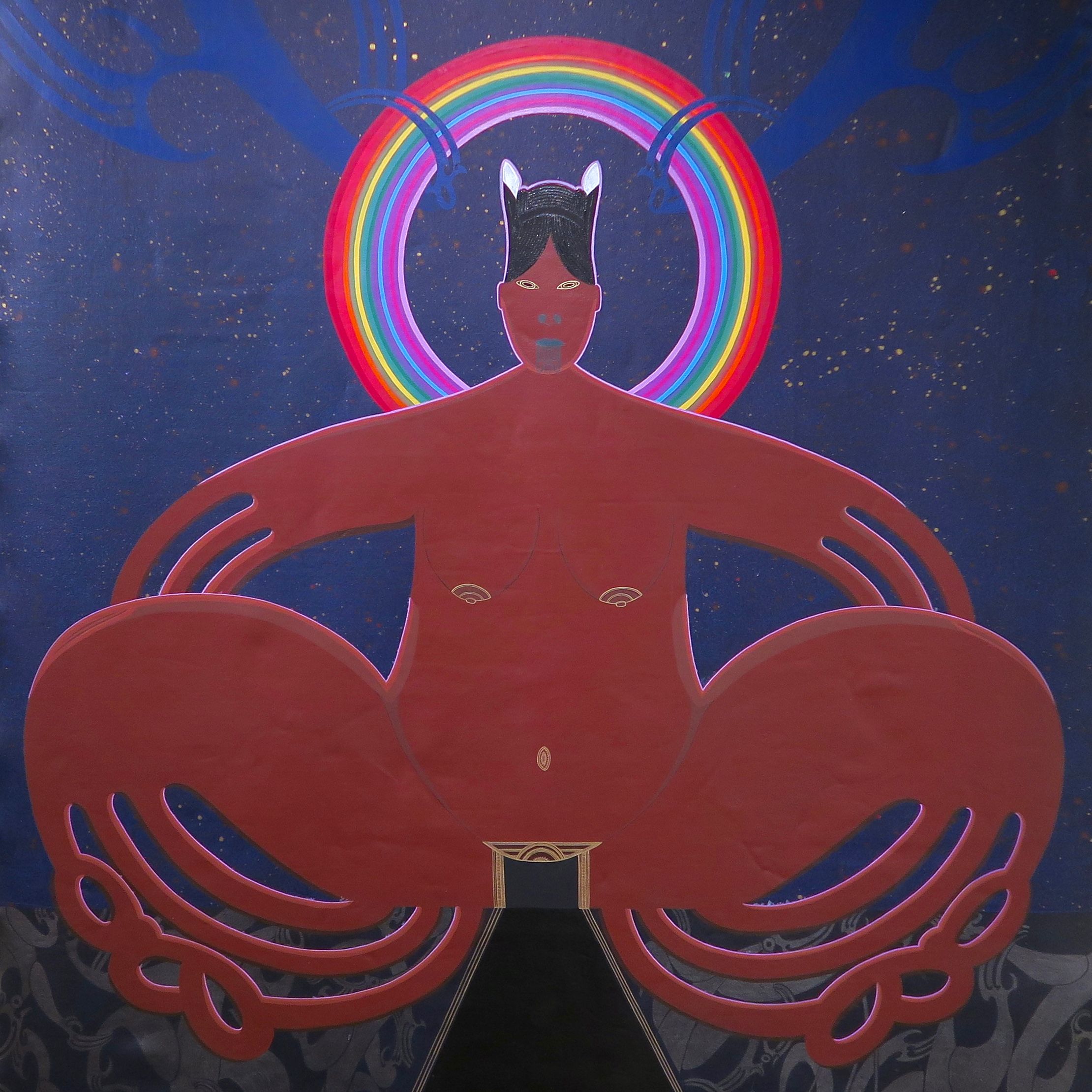Heart Talk: Māori Metamorphosis
Maia Keane writes about moving home to Tūranganui-a-Kiwa for art - and the sense of belonging and connection she has since discovered.

Ko Mātiti te maunga
Ko Maraetaha te awa
Ko Horouta te waka
Ko Muriwai me Rangiwaho ngā marae
Ko Ngāi Tāmanuhiri me Rongowhakaata ngā iwi
Ko Maia Keane ahau
Tēnā tātou katoa
He wahine Māori, he kaitiaki, he ringatoi hoki. My art practice is as a painter, kairaranga and curator. All of my mahi is centred in the guardianship of taonga tuku iho — treasures passed down through generations. Taonga tuku iho are more than just physical taonga such as raranga or whakairo.
They include knowledge, tikanga, whakapapa, as well as the art forms themselves, held and carried by us as uri, as kaitiaki of our people’s stories. For me, the act of creating is inseparable from the responsibility to protect, honour and continue these legacies.
Six years ago, I moved to Tūranganui-a-Kiwa to pursue toi Māori. This wasn’t the start of my relationship with this whenua, though. My mum used to send me and my sister back to our pā, Muriwai, every school holiday so we could live out our pā kid fantasies — riding through paddocks on our bikes, climbing pōhutukawa trees, and hanging out with our cousins. I always cried when it was time to leave. The kids at school didn’t get me the way my cousins did. But my mum believed there were more opportunities for me in Tāmaki Makaurau. I guess she didn’t know back then that all I’d ever really cared about or wanted to be was Māori.
I think about that little girl often. She’d be so happy about the life I’ve lived in Tūranganui-a-Kiwa — the relationships I’ve built, the mahi I’ve executed, and the person I’ve grown to become. I came here for art but ended up rediscovering a sense of belonging I didn’t even realise I was searching for.
Over the years, I’ve been blessed to work with and alongside some incredible people in Te Tairāwhiti. Tohunga who have shared their wisdom so generously, reminding me that learning never ends. Rangatahi who have shown me the simple, unfiltered joy in creating, and in making without fear. My peers, my fellow ringatoi, who continue to push boundaries and open doors for all of us, proving that creativity is a collective effort, not a solitary act.
Since I moved here, I’ve been part of exhibitions, residencies, teaching, and conservation and curating projects. I’ve woven connections: not just tukutuku panels but real, lasting relationships. The taonga that shines brightest in my memory is revealing my moko kauae at Rangiwaho Marae mokopapa on 12 October 2024. That day wove everything together: my whakapapa, my practice, my healing, my identity. I was completely immersed in aroha.
The first time I visited Rangiwaho Marae was in 2022, to assist with the painting of new kōwhaiwhai. I knew it was work that would outlive me. The marae was alive that day, with laughter and storytelling from whānau echoing through the wharenui. Outside, the sky was a bright, endless blue, stretching out over the rolling maunga that cradled us like kuia watching over their mokopuna.
Our new poupou were painted with that same blue, blending up to the sky, almost floating into the passing clouds. The sun’s rays crept in through the windows, tracing light over our hands and intertwining with our brushes. Inside the whare, I sat hunched over, a 1mm liner brush in hand, shuffling up and down the lengths of kōwhaiwhai panels, tightening up every kape or koru that I saw.
Some people might think I was taking the work too seriously; my aunty eventually told me, “Hurry up now babe, this isn’t an exhibition!” But I disagreed. Aunty, bro, this is the most important exhibition I’ll ever do. Trust, the 1mm brush was necessary.

This type of mahi epitomises for me what it means to be a ringatoi Māori. In te ao Māori, to be an artist is to take on a huge responsibility for your iwi. To follow the ancestral art forms of raranga, moko, whatu, whakairo, tukutuku; this is a way to keep your people safe, beautiful, strong and loved.
Rangiwaho was re-revealed with new kōwhaiwhai and poupou in October 2022. I wasn’t there to see them erected, though. Ironically, after spending countless hours at hongi distance with the kōwhaiwhai, I was in Aussie visiting whānau when the unveiling took place. I heard about the mokopapa that was held to mark the milestone, too. That was the first time I truly felt the pull to jump on the table myself, to step into the space of receiving my moko kauae.
But I wasn’t ready. I was still healing, still figuring some stuff out. I wonder now if my papa knew to keep me away, navigating time from above the clouds to prepare me for what was to come. Back then, it felt like something so far away, something I longed for but couldn’t quite see myself doing.
Then in 2024 the call became undeniable. This time, I wasn’t watching from a distance or imagining what it might be like. I stood at that same marae, surrounded by those same walls and patterns that I had spent hours painting and perfecting.
Receiving my moko kauae felt like coming full circle, like stepping into the legacy I had helped to uphold. The patterns etched onto my skin felt like a continuation of the kōwhaiwhai I had once held in my hands. A story that I was now wearing, forever tied to this whenua and this wharenui.
The week following our mokopapa, I opened a group exhibition titled too much you fullas at Te Whare Taonga o Te Tairāwhiti. The show became a mihi to those who have shaped my journey here. Curating this show was about more than just sharing art: it was a celebration of the creative abundance within our community. The title, playful yet proud, speaks to the brilliance of us here in Te Tairāwhiti; the way we uplift each other, create alongside each other, and reflect the strength of our whakapapa in the work we do.
The artists I included weren’t just peers, they were my friends, mentors, students, role models and whānau. My partner, Heremaia, who I grew alongside as a tauira, and then taught beside as a kaiako. My mentors, Melanie Tangaere Baldwin, Michael Spedding, Steve Gibbs, Sue Lloyd and Jolene Douglas, who taught me to chase my passion unapologetically. My cousin, Tui Fay, an amazing kairaranga who first taught me and my sister about our whakapapa as city kids visiting home for the holidays.
My students, whose growth in toi Māori fills me with so much pride. Some of my own mahi was in the exhibition, too. I displayed my first attempt at tāniko, in a bright-pink sunset intertwined with the natural glow of muka. I wore this tāniko piece around my neck as I lay on the table to receive my moko kauae.

I even included the kaitā who gave me my moko kauae, Ngaire Tuhua. Her painting in this exhibition is called Tatau o te ora, a grand portrait of Hinenui, drawn as an archetype of creation and connection. Her form dominates the space, unapologetically full and commanding, grounded in the undeniable presence of her kōpū — a vessel of life, memory and generational strength. A rainbow surrounds her head like a halo, guiding us to see Hinenui as a mediator of both light and darkness.
The painting evokes all of the wāhine I know in Tairāwhiti. It feels like a mirror to our community, and a powerful reminder of the strength, grace and resilience of wāhine Māori. I’m reminded of this strength every time I look in the mirror now, too, thanks to Ngaire. Hinenui I am.

As I move into whatever’s next for me, I feel this overwhelming gratitude for everything Tairāwhiti has given. It’s not just a place I’ve lived, it’s a place that’s lived within me, and it always will. This place is magic. Te Tairāwhiti is the centre of the universe, and it is the centre of mine. Really the magic here is in being Māori.
This journey has taught me that creativity doesn’t exist in isolation. So all you fullas, draw on the aroha and mātauranga that surrounds you. Be unapologetic in your pursuit of toi. And remember, your creativity is an act of survival, a duty to the people who came before you and who will follow after you. Share your voice, your vision and your heart, because they are needed, now more than ever.
Trust in your whakapapa, lean on your neighbours, and carry the magic of being Māori into everything you do.
Kia whakatōmuri te haere whakamua.
I walk backwards into the future with my eyes fixed on my past.
The HEART TALK Series is brought to you Art Makers Aotearoa and was commissioned and produced by Van Mei, with copy-editing by Marie Shannon and funding support from Creative New Zealand.